ARCHAEOLOGY
Paper – II
Note : This paper contains fifty (50) objective type questions of two (2) marks each. All questions are compulsory.
1. The longest part of the human past is
(1) Stone Age
(2) Bronze Age
(3) Iron Age
(4) Chalcolithic Age
2. Bhimbetka, one of the most magnificent rock art sites in the world, was discovered by
(1) H.D. Sankalia
(2) V.N. Misra
(3) V.S. Wakankar
(4) G.R. Hunter
3. Australopithecus anamensis was discovered by which of the following ?
(1) L.B.S. Leakey
(2) Richard Leakey
(3) Meave Leakey
(4) Donald Johnson
4. Yediapur is a primary context site of
(1) Lower Palaeolithic
(2) Middle Palaeolithic
(3) Upper Palaeolithic
(4) Mesolithic
5. The bone figurine was recovered in upper Palaeolithic period from which of the following regions ?
(1) Sohan Valley
(2) Son Valley
(3) Belan Valley
(4) Mahanadi Valley
6. Which of the following Harappan sites has produced a well ?
(1) Kunal
(2) Farmana
(3) Lohat
(4) Banawali
7. Which of the following Harappan sites has produced burials ?
(1) Balu
(2) Banawali
(3) Rakhigarhi
(4) Baroor
8. The famous Ajanta painting of ‘Mother and Child’ is depicted in which cave ?
(1) No. 1
(2) No. 9
(3) No. 16
(4) No. 17
9. It is evident from archaeological remains that the earliest solid stupa made of bricks from base to the top was built at
(1) Amaravati
(2) Bhattiprolu
(3) Ghantasala
(4) Jaggayapeta
10. Who among the following was issuer of Karthikeya type gold coins ?
(1) Chandragupta II
(2) Kujula Kadphises
(3) Kumaragupta I
(4) Chandragupta I
11. Which of the following sites has revealed the Black and Red Ware for the first time in Neolithic context ?
(1) Chirand
(2) Martand
(3) Kuchai
(4) Daojali Hading
12. Which of the following sites has yielded a terracotta plaque depicting a child writing alphabet ?
(1) Atranjikhera
(2) Sugh
(3) Thanesar
(4) Sannati
13. Which of the following is the characterizing symbol of the Chola coins ?
(1) Garuda lanchhan
(2) Singha lanchhan
(3) Varaha lanchhan
(4) Vyaghra lanchhan
14. Northern Black Polished ware was found for the first time from which of the following sites ?
(1) Bhir Mound Taxila
(2) Hastinapur
(3) Kausambi
(4) Rajaghat
15. Depictions at Bhimbetka rock shelters include
a. Elephants
b. Rhinoceros
c. Wild Buffalo
d. Snakes
Codes :
(1) a, b, c
(2) b, c, d
(3) a, c, d
(4) a, b, c, d
16. The Neolithic sites of Andhra Pradesh are
a. Hallur
b. Brahmgiri
c. Veerapuram
d. Kesarpalli
Codes :
(1) a and b
(2) b and c
(3) c and d
(4) a and d
17. In Africa, pre-Acheulian industries are associated with which of the following homonid remains ?
a. Australopithecines
b. Homo habilis
c. Homo erectus
d. Homo sapians
Codes :
(1) a and b
(2) b and c
(3) a and d
(4) c and d
18. Which of the following sites are located in Odisha ?
a. Karur
b. Kuchai
c. Ollaiyur
d. Baidyapur
Codes :
(1) a and b
(2) b and c
(3) b and d
(4) c and d
19. Which of the following sites are located on the left bank of the Indus river ?
a. Kile Ghul Muhammad
b. Kot Diji
c. Sanaikhola
d. Chanhudaro
Codes :
(1) a and b
(2) b and c
(3) c and d
(4) d and a
20. Which of the following inscriptions refer to Vaisnavism ?
a. Poona Copper Plate Inscription
b. Besnagar Pillar Inscription
c. Hathi Gumpha Inscription
d. Junagarh Inscription of Skandagupta
Codes :
(1) a and c
(2) b and d
(3) b and c
(4) c and d
21. Who among the following notable Sanskrit authors were Panegyrists also ?
a. Bharavi
b. Harishena
c. Kubja
d. Vatsabhatti
Select the correct answer from the code given below :
Codes :
(1) a, b and c
(2) b, c and d
(3) a and d only
(4) c and d only
22. The dance poses (Karanas) described in the Natyasastra are depicted in which of the following temples ?
a. Brihadishwara temple
b. Chidambaram temple
c. Kailasanatha temple Kanchipuram
d. Narttamalai temple
Select the correct answer from the codes given below :
Codes :
(1) a only
(2) b only
(3) a and b
(4) c and d
23. Consider the following statements :
Assertion (A) : Our knowledge of the dwellings and material culture of the Mesolithic people is very limit.
Reason (R) : Items made of organic material hardly survive.
Codes :
(1) (A) and (R) both are correct and (R) is correct explanation of (A).
(2) (A) and (R) both are correct and (R) is not the correct explanation of (A).
(3) (A) is correct and (R) is wrong.
(4) (A) is wrong and (R) is correct.
24. Consider the following statements :
Assertion (A) : There is no unanimity about horse remains from Harappan levels.
Reason (R) : With wild onager still thriving in the region, it is difficult to distinguish it from the horse.
Codes :
(1) (A) and (R) both are correct and (R) is correct explanation of (A).
(2) (A) and (R) both are correct and (R) is not the correct explanation of (R).
(3) (A) is correct and (R) is wrong.
(4) (A) is wrong and (R) is correct.
25. Consider the following statements :
Assertion (A) : Robert Bruce Foote was a geologist of the Geological Survey of India.
Reason (R) : He found a handaxe in a gravel pit at Pallavarm in outskirts of Chennai.
Codes :
(1) Both (A) and (R) are correct and (R) is the correct explanation of (A).
(2) Both (A) and (R) are correct and (R) is incorrect explanation of (A).
(3) (A) is correct, but (R) is incorrect.
(4) (A) is incorrect, but (R) is correct.
26. Consider the following statements :
Assertion (A) : Hakraware was discovered from stratified deposits in Bahawalpur region.
Reason (R) : This region was the epicentre of the beginning of Harappan civilization.
Codes :
(1) (A) is correct, but (R) is wrong.
(2) Both (A) and (R) are wrong.
(3) Both (A) and (R) are correct, but (R) is incorrect explanation of (A).
(4) Both (A) and (R) are correct and (R) is the correct explanation of (A).
27. Consider the following statements :
Assertion (A) : The Harappa civilization originated from the early Harappa Culture.
Reason (R) : Several settlements have produced remains of both the phases.
Codes :
(1) (A) is correct, but (R) is wrong.
(2) Both (A) and (R) are wrong.
(3) Both (A) and (R) are correct and (R) is the correct explanation of (A).
(4) Both (A) and (R) are correct, but (R) is the incorrect explanation of (A).
28. Consider the following statements :
Assertion (A) : The Northern Black Polished ware is frequently available from settlements in the Indo-Gangetic divide.
Reason (R) : The technique to produce this ware was known in this region.
Codes :
(1) Both (A) and (R) are correct, but (R) is the incorrect explanation of (A).
(2) Both (A) and (R) are correct and (R) is the correct explanation of (A).
(3) Both (A) and (R) are wrong.
(4) (A) is wrong, but (R) is correct.
29. Consider the following statements :
Assertion (A) : Indian inscriptions engraved into stone or other durable materials are an important historical source.
Reason (R) : They also document the development and use of the written language in India.
Codes :
(1) (A) is correct, but (R) is incorrect.
(2) (A) is incorrect, but (R) is correct.
(3) Both (A) and (R) are correct and (R) is the correct explanation of (A).
(4) Both (A) and (R) are correct, but (R) is incorrect explanation of (A).
30. Consider the following statements :
Assertion (A) : Archaeological evidence shows that Buddhism was still lingering in North India in the 12th Century A.D.
Reason (R) : The images of Buddhist gods and goddesses of the Tantric school have been excavated in large numbers at places like Kausambi and Mathura.
In the conext of the above, which of the following is correct ?
Codes :
(1) Both (A) and (R) are true and (R) is the correct explanation of (A).
(2) Both (A) and (R) are true, but (R) is not the correct explanation of (A).
(3) (A) is true, but (R) is false.
(4) (A) is false, but (R) is true.
31. Consider the following statements :
Assertion (A) : The obverse and reverse of the coins of Indo-Greek king Agathocles bear the images of male figures, Krishna and Balarama.
Reason (R) : This indicates that they were important enough to receive royal recognition.
Codes :
(1) (A) is correct, but (R) is wrong.
(2) Both (A) and (R) are correct and (R) is not correct explanation of (A).
(3) Both (A) and (R) are wrong.
(4) Both (A) and (R) are correct.
32. Consider the following statements :
Assertion (A) : The main factor for the rise of Cities in Magadha was wide scale use of iron.
Reason (R) : Because the wide scale use of iron led to surplus production.
Codes :
(1) Both (A) and (R) are correct, and explanation of (R) to (A) is also correct.
(2) Both (A) and (R) are correct and (R) is not correct explanation of (A).
(3) (A) is correct, but (R) is wrong.
(4) Both (A) and (R) are wrong.
33. Arrange in correct order the four-phase evolutionary sequence of microlithic :
a. Diminutive microlithic industry with pottery.
b. Geometric microlithic industry.
c. Non-geometric microlithic industry.
d. Geometric microlithic industry with pottery.
Codes :
(1) a, b, c, d
(2) d, c, b, a
(3) c, b, d, a
(4) b, c, a, d
34. Arrange the geological formations of Narmada valley in chronological order :
a. Devakachar formation
b. Jhalon formation
c. Shobpur formation
d. Narsinghpur formation
Codes :
(1) a, b, c, d
(2) d, c, b, a
(3) c, d, a, b
(4) b, a, d, c
35. Arrange the following prehistoric sites in chronological order :
a. Inamgaon
b. Patpara
c. Tarsang
d. Mahadev Piparia
Codes :
(1) d, a, b, c
(2) b, c, a, d
(3) d, b, a, c
(4) c, b, d, a
36. Arrange the following sites in chronological order :
a. Jakhera
b. Balathal
c. Jalilpur
d. Mehrgarh
Codes :
(1) d, b, a, c
(2) b, d, c, a
(3) d, c, b, a
(4) c, a, d, b
37. Arrange the following sites in chronological order :
a. Agiabir
b. Bahadrabad
c. Rohina
d. Mahurjhavi
Codes :
(1) b, d, a, c
(2) d, a, c, b
(3) c, a, d, b
(4) c, b, a, d
38. Which of the following gold coin-types of Samudragupta bear only his name and no metrical legend ?
a. Archer-type
b. Battle-axe type
c. Lyrist type
d. Tiger-slayer type
Select the correct answer from the code given below :
Codes :
(1) a and b
(2) a and c
(3) b and c
(4) c and d
39. Arrange the following parts of Asokan Monolithic Pillars in ascending order.
a. Crowning animals
b. Persepolitan bell
c. Abacus
d. Tapering pillars
Codes :
(1) d, a, c, b
(2) b, a, c, d
(3) d, c, b, a
(4) c, b, a, d
40. Arrange the following examples of Jaina art in the chronological order :
a. Jaina Tirthankara images of Mathura.
b. Gajalakshmi depicted in Khandagiri, Odisha.
c. Cave I Udayagiri, Odisha.
d. Meguti temple, Aihole.
Select the correct answer from the code given below :
Codes :
(1) a, b, c, d
(2) b, c, d, a
(3) a, c, d, b
(4) d, a, b, c
41. Match the items of List-I with those of List-II.
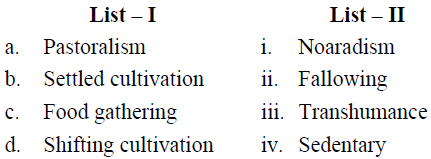
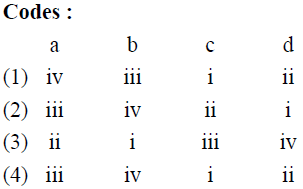
42. Match the items of List-I with those of List-II and choose the correct answer from codes given below :


43. Match sites of List-I with the excavators of List-II.
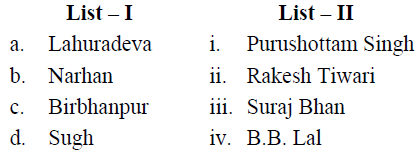

44. Match sites of List-I with the rivers of List-II.
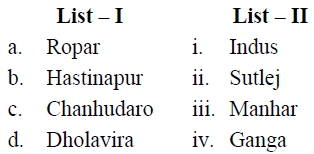

45. Match the sites of List-I with the rivers of List-II.
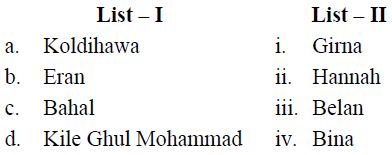
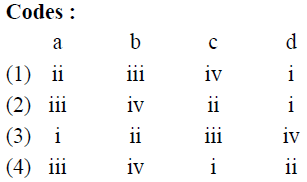
46. Match List-I with List-II and select the correct answer from the codes given below :
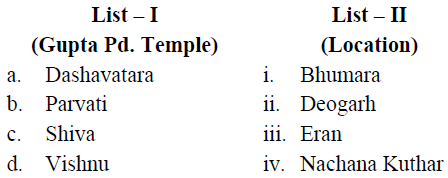
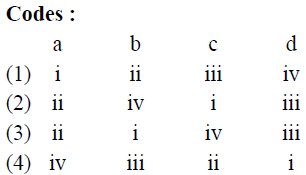
47. Match List-I with List-II and select the correct answer from the codes given below :
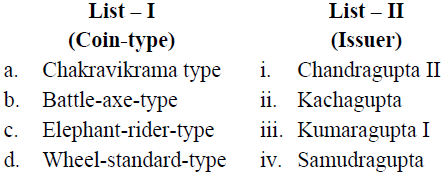
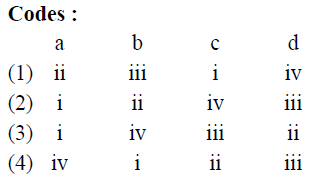
48. Match the books of List-I with authors of List-II.

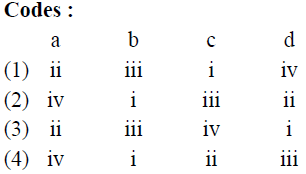
49. Match the items of List-I with those of List-II.
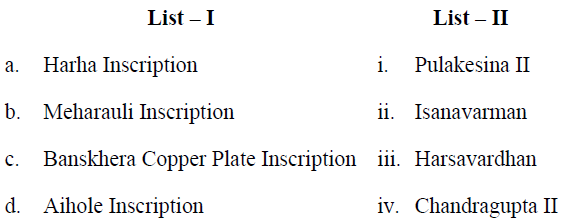
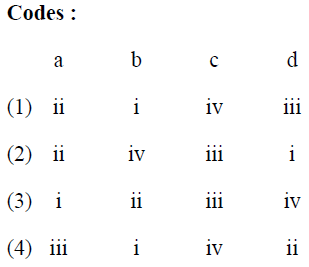
50. Match the items of List-I with those of List-II.
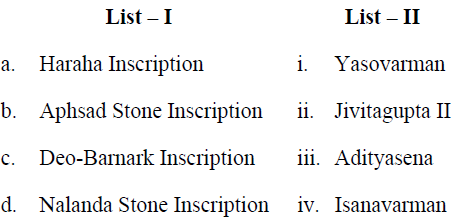

Latest Govt Job & Exam Updates: